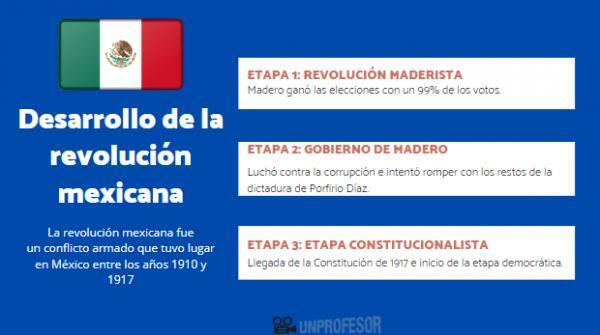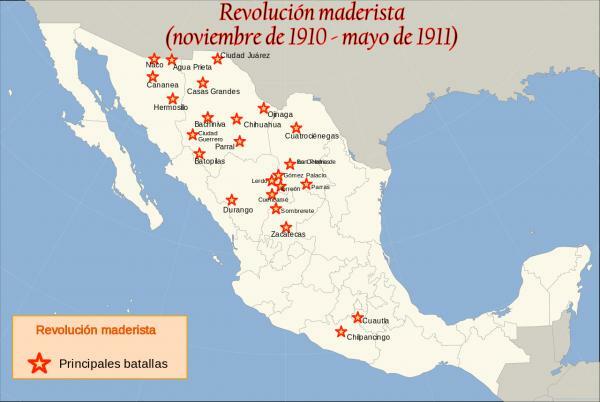Development of the Mexican REVOLUTION

The Mexican Revolution was a armed conflict that took place in Mexico between the years 1910 and 1917, being characterized by a series of socialist, liberal and anarchist movements that faced the regime of Porfirio Díaz. To talk about the evolution of this huge movement in this lesson from a PROFESSOR we must talk about the development of the mexican revolution.
Index
- Maderista Revolution
- Madero Government
- Constitutionalist stage of Mexico
Maderista Revolution.
Before talking about the development of the Mexican Revolution, it is important to know some key aspects of this revolt. In 1910, the president of Mexico it was Porfirio Diaz, being a dictator who had ruled for 30 years thanks to the support of the upper classes and the great western nations that supported him.
After so many years in power, it was said that he was tired of governing and it was a large number of politicians who proposed themselves as successors, being one of the most relevant
Francisco Madero that he had won the people's love for his popular politics. After a change of decision, Díaz ran for election again, locking up Madero so that he could not be his opposition and winning the elections for it.After leaving prison, Madero went into exile to the United States, being the place from where he asked the Mexicans for a military and revolutionary uprising to end the Diaz regime. This revolutionary uprising was called the San Luis Plan, being the beginning of the revolts of the lower classes to stop Porfirio and start the so-called Maderista revolution.
The revolution made important figures of the Mexican revolution such as Pancho Villa or Emiliano Zapata join the movement, creating a total movement in the nation and that finally ended with the resignation of Porfirio Díaz and an agreement signed between the dictator and Madero in which the former obtained his freedom towards Europe and the second take power in Mexico, being the beginning of the confrontations between Madero and the leaders revolutionaries.
In 1911 an extraordinary election was held, being won by Madero with 99% of the votes, becoming the revolutionary in the new president of the region. From that moment on, there were many divisions within the movement of the Mexican RevolutionAn example being the disputes between Madero and Zapata and the agrarians.

Government of Madero.
The Madero government had the great problem that it had to fight corruption created during the Diaz dictatorship, but they also had to confront those allied people during the revolution who were now facing the Madero government.
A clear example of confrontation was the Ayala Plan, being a military uprising carried out by Emiliano Zapata, an important member of the revolution and caused by the fact that the reforms that Madero had promised to the agrarian sector did not arrive.
Madero, meanwhile, was trying destroy power structures created by the Diaz government, but it still lacked the lower classes. Madero kept the army that had defended Díaz since it was still the army that defends the president, but not He maintained a revolutionary army that supported Zapata by seeing how Madero did not fulfill his promises to the peasants and workers.
The struggles between the faithful to Madero and Zapata were maintained throughout the nation, but it was not the Zapata revolutionaries who finished off Madero, but that it was a coup that ended Madero's administration and shortly after his death at the hands of Victoriano Vegetable plot.
Victoriano Huerta established a dictatorship similar to that of Porfirio Díaz, seeking to destroy what was created by Madero and return to Mexico where inequality and the upper classes reigned were the dominant forces, but he did not count on the revolts of the people who had already fought against Diaz. Villa, Zapata and the rest of the revolutionaries formed the so-called constitutionalist army to overthrow Huerta.

Image: Slideshare
Constitutionalist stage of Mexico.
To finish this lesson on the development of the Mexican Revolution we must talk about the call constitutionalist stage, named after the arrival of the Constitution of 1917.
The dictatorship created by Huerta had the situation of the peasants worsened of Mexico, causing this that many revolutionaries took up arms against Huerta. In 1914, and after invading some of the main regions, the president Huerta was forced to leave the post, being replaced by Venustiano Carranza, who was supported by Villa and Zapata.
Shortly after, and after many disputes between the different revolutionary leaders, all of them agreed to sign the Constitution of 1917. The arrival of this great law opened a new era for the history of Mexico, being essential for the American nation to become a truly democratic region and never have another dictatorship.
The 1917 Constitution was very important especially for the agricultural sector, being many those who benefited from the change of the lands from the upper classes to the upper classes low and leading to this that Mexican society evolve towards greater equality between classes social.
With the death of Villa and Zapata, a few years later the revolutionary spirit disappeared that had characterized Mexico in recent years, but the achievements they achieved during the The revolution were key to the evolution of the American nation and therefore remembered as heroes. Democracy remained strong in Mexico and there was no longer a need for new revolutions.

If you want to read more articles similar to Development of the Mexican Revolution, we recommend that you enter our category of Story.



